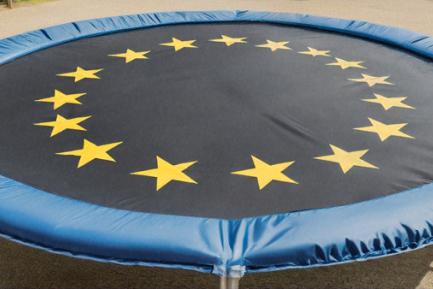Next Generation EU funds: current status and how they affect you
Spain included 28.4 billion euros from the Recovery and Resilience Mechanism, NGEU’s main instrument, in the 2022 General Government Budget. Have expectations been met? Are the investments and reforms being implemented as planned?

Many projects were launched in 2022 (see first chart), amounting to around 25.1 billion euros (88% of the total amount budgeted) according to budget execution data. This includes calls to apply for financial support and competitive tenders, as well as areas where funds have begun to be distributed to the regional, local and public institutions that are executing the investment programmes. However, when analysing the execution of funds, this estimate is too broad, as it includes projects in which the funds are available to the public sector (or will be imminently) but where the beneficiaries of the associated aid have not yet been selected. In other words, the money is still «in the pipeline». If we look at the projects that have been launched in 2021-2022 since the NGEU programme was kick-started, they come to over 47 billion euros, or 90% of the total budget.

However, if, rather than looking at the funds that have been budgeted for, we stick to the funds which have been allocated (or committed, in budgetary jargon), then we will get a slightly more precise idea of the rate at which the investments are reaching the real economy. Using this criterion, we find that the central government allocated funds worth 21.9 billion euros out of the 2022 budget (42.9 billion in 2021-2022).1 This represents 77% of the total budget, although a portion of this amount was allocated to the autonomous community regional governments, local government corporations and public entities and companies in order for them, in turn, to launch the corresponding tender processes or calls for applications for the final recipients of the funding. In particular, of this sum of 21.9 billion that has been allocated, we estimate that around 6.2 billion (28%) has been awarded to private companies through calls for applications. Of this 6.2 billion, 2.2 billion was awarded in the first half of the year and 4.0 billion in the second half, suggesting an acceleration in the rounds of funding being granted to the private sector in the second half of the year.
In the second chart, we can distinguish the main allocations of NGEU funds by the central government in 2021 and 2022.2 Some of the biggest allocations include projects in railway infrastructure, the programme for funding SMEs and self-employed workers through loan guarantees, the Digital Kit programme to fund the digitalisation of self-employed workers and SMEs, and programmes in sustainable mobility and urban transformation, as well as energy projects with a clear commitment to sustainability (building refurbishments to improve energy efficiency).
- 1. The funds committed in 2021-2022 accounted for 81.5% of the total funds budgeted for in the two years as a whole.
- 2. In total, the central government awarded calls for funding in 2021-2022 amounting to 19.2 billion euros (including funds awarded to private companies, as well as direct aid awarded to other public entities where they are the final recipients and are not required to open a call for applications to subsequently pass on the funding). In addition to this, we must add 4.1 billion of funds awarded by the autonomous community regional governments to the final recipients.

If we want to be even more precise and drill down to the final layer, that is, the amount of funds that has reached the productive fabric of the economy, then the figure will be less than the funds allocated, since the beneficiaries have to present documentation before the payment is executed. If we focus on disbursements from the central government to the final recipients (i.e. payments to the private sector and payments of direct aid to other public entities, but excluding transfers to other public entities where they in turn must publish a call for funding applications in order to subsequently allocate the funds, and aid for technological, university and educational centres) in terms of what was budgeted for in 2022, we find that the central government disbursed 8.2 billion euros, or 30% of the amount budgeted in that year.3 However, the acceleration in the second half of last year was palpable: the central government disbursed funds amounting to almost 6.0 billion euros, tripling the amount disbursed in the first half of the year.
As for the so-called PERTE projects (Strategic Projects for Economic Recovery and Transformation), which have a high potential to drive the transformation of the economy and involve significant public-private collaboration, the calls for applications launched in 2021-2022 (i.e. the sum of the calls opened and those awarded) totalled 12.3 billion euros (almost 30% of the total of 47.0 billion euros in projects launched in 2021-2022). This sum included 4.9 billion allocated to the renewable energies PERTE project, 2.0 billion for the electric and connected vehicle PERTE project and 1.84 billion for the PERTE project related to the aerospace sector. It should be noted that, taking into account the reinforcement of the 18 billion in loans that are due to be channelled into the PERTE projects, the total public investment in these projects between 2022 and 2026 will exceed 40 billion euros.
As for 2023, the European funds are expected to play a greater role in the economy: there are many projects that have already been launched and that should crystallise by reaching the productive fabric of the economy, and a steady cruising speed is expected to be maintained in the rhythm of calls for applications and disbursements, as was observed in the second half of 2022. In addition, the figures announced for calls for funding applications in the first half of 2023 demonstrate how the budget is concentrated in just a handful of large-scale awards4 and it should be the year in which major funding application processes are opened for some of the larger PERTE projects, such as the one related to renewable energies and green hydrogen, as well as the second round for the PERTE project related to the industrial chain of the electric and connected vehicle (in the first round, projects amounting to 793 million were awarded funding, representing only a portion of the almost 3 billion budgeted).
If everything that was anticipated in 2022 and a portion of what is budgeted for in 2023 is finally executed (the total figure could exceed 20 billion euros in execution),5 then the macroeconomic impact on growth in 2023 would be substantial, potentially amounting to 1.0 pp. Ensuring that the funds are executed quickly in 2023 will also be key in order for the disbursement of the European funds to continue: the first disbursements depended primarily on reforms being carried out, but as we move forward the importance of meeting quantifiable targets related to the investments will gain weight. Even this year, in 2023, there will be quantitative targets to be met based on measurements since the Plan began. Among others, these targets will include: 231,000 refurbishment works carried out on at least 160,000 homes, a minimum fleet of 238,000 vehicles and charging points, 800,000 SMEs benefited from the Digital Kit, and an 8,500-MW increase in the installed capacity of renewables.
- 3. Data up to November 2022.
- 4. The five biggest calls for funding applications in the spheres of the green transition, digitalisation, trade and tourism, education and employment account for at least 70% of the total aid available in each of these sectors. Some 11.6 billion euros have been budgeted for in calls for funding in the first half of 2023.
- 5. By execution, we mean that the funds have been disbursed and the productive economic agents have access to them.
The schedule of reforms agreed upon by Brussels in the first half of 2022 was met, and this has allowed the European Commission to give the green light in February to the disbursement of European funds worth 6.0 billion euros, with Spain due to receive the full sum shortly once the European Council has given its final approval. Some of the key reforms that are planned include the law aimed at promoting company pension plans which will increase the maximum tax-deductible joint contribution of worker and company to 10,000 euros,6 as well as the new system for self-employed workers’ social security contributions based on a set of standardised criteria known as «modules».
In the second half of the year there was an acceleration in the passing of laws aimed at modernising general government administrations, such as the approval of the bill for a reform of public sector workers which, among other elements, introduces a component of their remuneration linked to annual performance reviews. In addition, Congress passed the Public Policy Assessment Act to evaluate, both ex ante and ex post, the results of public policies with the creation of a Public Policy Assessment Agency. According to the schedule of the Recovery Plan, we should learn more about how this agency will function in Q3 2023, and it would be desirable for the assessments to be conducted by independent and external evaluators. The Employment Act also came into force, which gives job seekers a maximum period of one month following their initial assessment to establish a tailored plan to find work, as well as boosting the use of digital tools and assessment mechanisms in how the state employment service (SEPE) operates.
- 6. However, a plan with tax incentives to facilitate mobility between alternative plans has not been established.

However, in the sphere of pensions, the second part of the reform, focused on changes in how the number of years of social security contributions affects the calculation of a person’s pension as well as an increase in the maximum contribution base and the maximum pension amount, is not yet finalised. It would be desirable for this reform to ensure the sustainability of the system by balancing the interests of all generations; this reform is the only milestone left to go in order for funds amounting to 10 billion euros, linked to the progress made in the second half of 2022, to be disbursed in mid-2023.
- 1. The funds committed in 2021-2022 accounted for 81.5% of the total funds budgeted for in the two years as a whole.
- 2. In total, the central government awarded calls for funding in 2021-2022 amounting to 19.2 billion euros (including funds awarded to private companies, as well as direct aid awarded to other public entities where they are the final recipients and are not required to open a call for applications to subsequently pass on the funding). In addition to this, we must add 4.1 billion of funds awarded by the autonomous community regional governments to the final recipients.
- 3. Data up to November 2022.
- 4. The five biggest calls for funding applications in the spheres of the green transition, digitalisation, trade and tourism, education and employment account for at least 70% of the total aid available in each of these sectors. Some 11.6 billion euros have been budgeted for in calls for funding in the first half of 2023.
- 5. By execution, we mean that the funds have been disbursed and the productive economic agents have access to them.
- 6. However, a plan with tax incentives to facilitate mobility between alternative plans has not been established.


